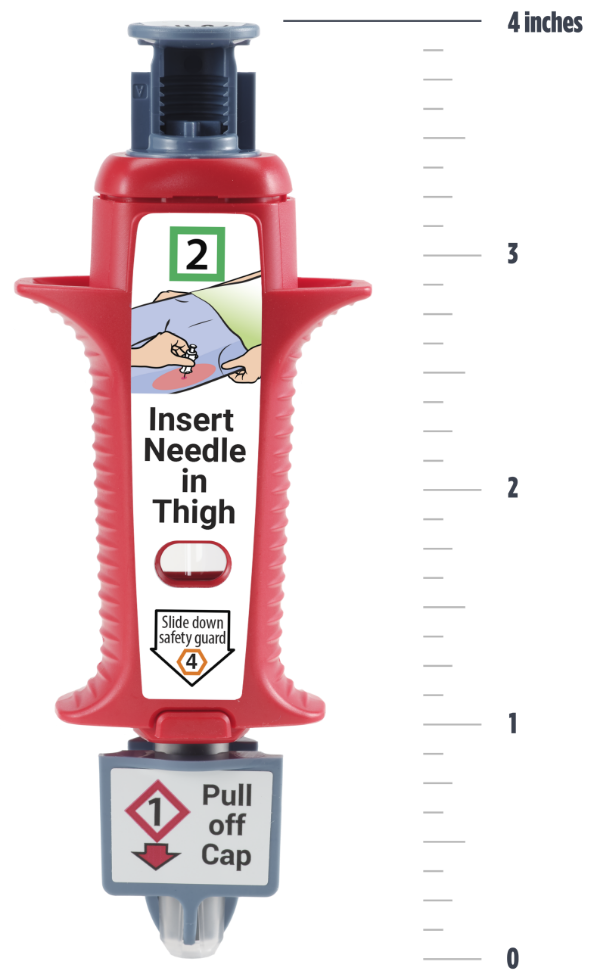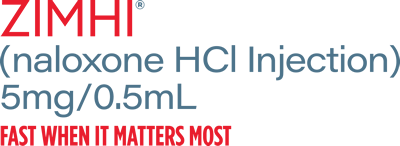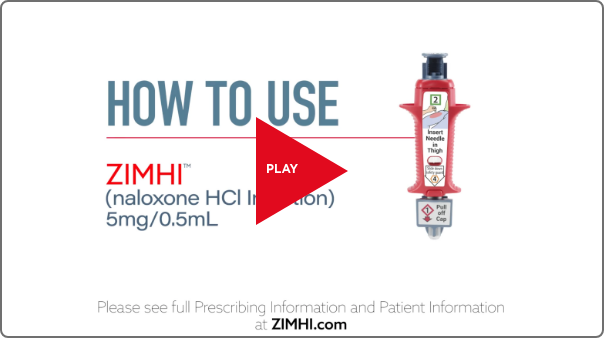ZIMHI IS GIVEN IN 4 SIMPLE STEPS
PRESS
needle into outer thigh after twisting off needle cap.
PUSH
plunger until it clicks to inject and hold for 2 seconds
before removing needle.
PULL
the safety guard over the needle using one hand, with
fingers behind the needle.
PLACE
the used syringe back into its blue case and close it.
911
Get emergency help.
If the patient is unresponsive after 2 to 3 minutes, give an
additional dose of ZIMHI using a new device.

ZIMHI can be
administered through
clothing, including jeans.
When every moment matters during an opioid overdose emergency rescue situation
ZIMHI IS GIVEN IN 4 SIMPLE STEPS
HOW TO USE ZIMHI1
PRESS
needle into outer thigh after twisting off needle cap.
PUSH
PULL
PLACE
the used syringe back into its blue case and close it.
911
Get emergency help.
If the patient is unresponsive after 2 to 3 minutes, give an additional dose of ZIMHI using a new device.

ZIMHI can be
administered through
clothing, including jeans.
100% OF PARTICIPANTS
used the ZIMHI prefilled syringe device without error in a human factors validation study (N=30).2
100% OF PARTICIPANTS
used the ZIMHI prefilled syringe device without error in a human factors validation study (N=30).2
WATCH A DEMONSTRATION OF HOW TO ADMINISTER ZIMHI
Download an Instructions-for-Use Flashcard to share with your patients.
DOWNLOAD INSTRUCTIONS

HELPFUL TIPS FOR TALKING TO
PATIENTS ABOUT ZIMHI
FAST ABSORPTION WITH ZIMHI
ORDER ZIMHI
In an opioid overdose emergency,
ZIMHI MAY MAKE ALL
THE DIFFERENCE
REQUEST A TRAINING DEVICE



In an opioid overdose emergency,
ZIMHI MAY
MAKE ALL THE
DIFFERENCE
REQUEST A TRAINING DEVICE



In an opioid overdose emergency,
ZIMHI MAY
MAKE ALL THE
DIFFERENCE
REQUEST A TRAINING DEVICE

References: 1. ZIMHI. Prescribing information. 2. Data on file. US WorldMeds. Human factors engineering/usability engineering report.
INDICATION
ZIMHI is an opioid antagonist indicated for the emergency treatment of known or suspected opioid overdose, as manifested by respiratory and/or central nervous system depression in adult and pediatric patients. ZIMHI is intended for immediate administration as emergency therapy in settings where opioids may be present. ZIMHI is not a substitute for emergency medical care.
IMPORTANT SAFETY INFORMATION
As the duration of action of naloxone hydrochloride is shorter than many opioids, keep the patient under continued surveillance and administer repeated doses of naloxone using a new ZIMHI device, as necessary, while awaiting emergency medical assistance.
Reversal of respiratory depression caused by partial agonists or mixed agonists/antagonists, such as buprenorphine and pentazocine may be incomplete. Repeat doses of ZIMHI may be required.
Use in patients who are opioid dependent may precipitate opioid withdrawal. In neonates, opioid withdrawal may be life-threatening if not recognized and properly treated. Monitor for the development of signs and symptoms of opioid withdrawal.
Abrupt postoperative reversal of opioid depression may result in adverse cardiovascular (CV) effects. These events have primarily occurred in patients who had pre-existing CV disorders or received other drugs that may have similar adverse CV effects. Monitor these patients closely in an appropriate healthcare setting after use of naloxone hydrochloride.
After use, the ZIMHI needle is exposed until the safety guard is deployed. A needlestick injury could occur during use in emergency situations. In the event of accidental needlestick injury, medical attention should be sought.
The following adverse reactions were most commonly observed in ZIMHI clinical studies: dizziness, lightheadedness, and elevated bilirubin.
To report SUSPECTED ADVERSE REACTIONS, call 1-800-230-3935 or FDA at
1-800-FDA-1088 or www.fda.gov/medwatch
IMPORTANT SAFETY INFORMATION and INDICATION for ZIMHI™
As the duration of action of naloxone hydrochloride is shorter than many opioids, keep the patient under continued surveillance and administer repeated doses of naloxone using a new ZIMHI device, as necessary, while awaiting emergency medical assistance.
Reversal of respiratory depression caused by partial agonists or mixed agonists/antagonists, such as buprenorphine and pentazocine may be incomplete. Repeat doses of ZIMHI may be required.
IMPORTANT SAFETY INFORMATION and INDICATION for ZIMHI™




